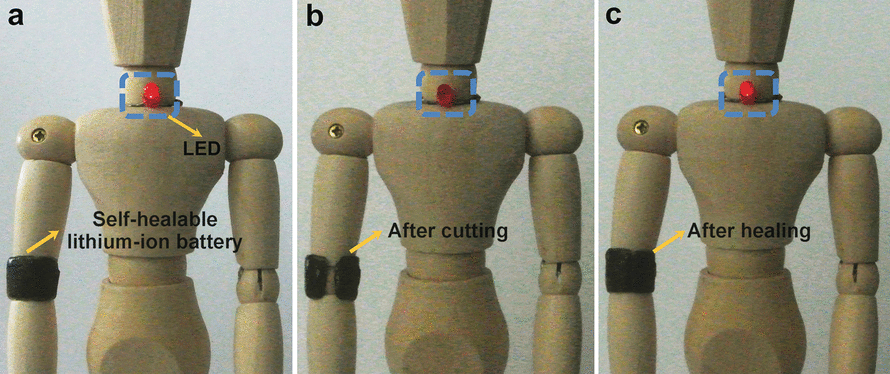Oct 21 2016
 Credit: Wiley
Credit: Wiley
Wearable electronics embedded in clothing are the latest growing trend, however power sources are still an issue. The development of lithium ion batteries that are thin, flexible, and possess self-healing properties has been reported by researchers in the journal Angewandte Chemie. These batteries can grow back together even after falling apart completely, without any major effect on their electrochemical properties.
The currently available lithium ion batteries used in wearable electronics are not affected when they are rolled up or bent, but tend to break when accidentally stepped on or twisted beyond an extent. Such incidents can occur quite often when worn. This type of damage not only leads to failure of battery, but also creates safety issues due to the leakage of toxic, corrosive, or flammable liquids or gases.
A new class of lithium ion batteries that can overcome such issues with their astounding self-healing powers have been developed by a group of scientists headed by Yonggang Wang and Huisheng Peng. For a complex object like a battery to be self-healing, all of the components in the battery must also posses self-healing properties. This has been made possible by researchers at the Fudan University (Shanghai, China), the Samsung R&D Institute China and the Samsung Advanced Institute of Technology (South Korea).
These self-healing batteries possess electrodes made of layers of parallel carbon nanotubes. The researchers have embedded the appropriate lithium compounds between these layers in nanoparticle form - LiTi2(PO4)3 for one electrode and LiMn2O4 for the other.
Unlike in the traditional lithium batteries, there can be no leakage of lithium compounds while in use or as a result of breakage, in the new batteries. The self-healing battery’s thin layer electrodes are placed on a substrate of self-healing polymer. A novel, solvent-free electrolyte that is produced using a cellulose-based gel embedded with an aqueous lithium sulfate solution, is present between the electrodes. This layer of electrolyte gel also helps to separate the electrodes.
In case of a break a user has to merely keep the broken pieces pressed together for a few seconds to make the battery grow back together. The carbon nanotubes and the self-healing polymers “stick” back together seamlessly.
Due to their parallel arrangement, the nanotubes stick together in a much better manner than the disordered layers of carbon nanotubes. The electrolyte also does not an issue. Although the traditional electrolytes decompose instantly when exposed to air, the new gel remains stable. As it does not contain any organic solvents, the gel is neither toxic nor flammable and hence, is safe for use in this application.
Even after repeated break/self-healing exercises, the charging/discharging properties and capacity of a battery “armband” that was positioned around the elbow of a doll were not affected.